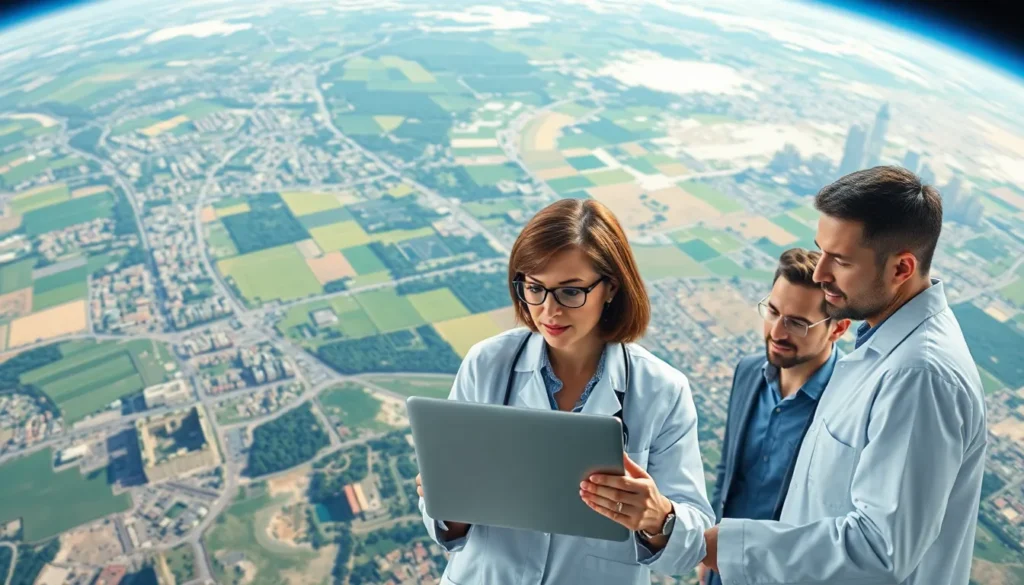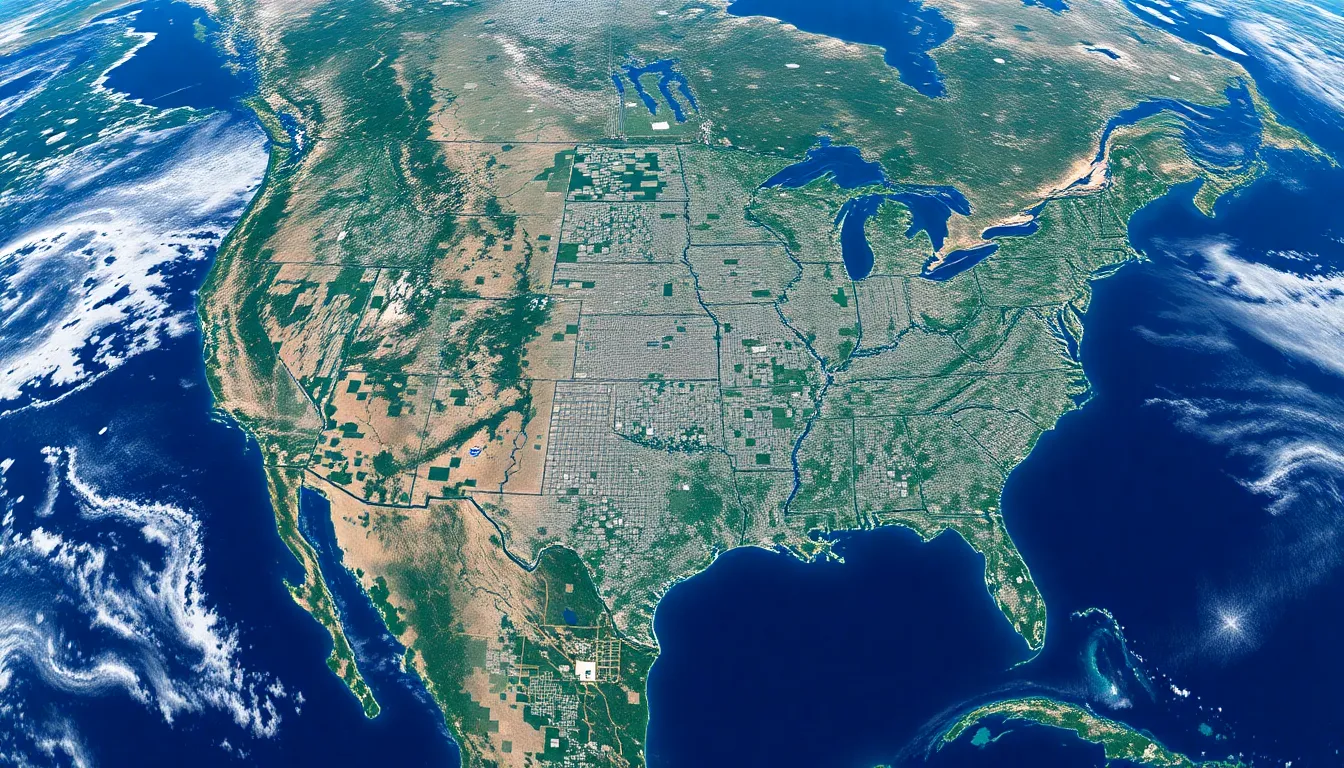In a world where even the clouds have their own Instagram accounts, satellite image analysis stands out as the unsung hero of data interpretation. It’s like having a bird’s-eye view of the planet, but without the pesky bird droppings. This fascinating field combines cutting-edge technology with a sprinkle of creativity, helping scientists, businesses, and even curious minds uncover hidden patterns and insights from above.
Imagine harnessing the power of satellites to monitor climate change, track urban development, or even locate that elusive parking spot. With satellite image analysis, the sky’s not the limit—it’s just the beginning. Dive into this captivating realm where pixels tell stories, and discover how satellite imagery is transforming our understanding of the Earth, one snapshot at a time.
Table of Contents
ToggleOverview of Satellite Image Analysis
Satellite image analysis refers to the examination of images captured by satellites for various applications. It plays a crucial role in interpreting data about the Earth’s surface. Techniques in image processing enhance the visual information captured, facilitating detailed observations.
Data scientists utilize satellite imagery to monitor environmental changes. Remote sensing helps in tracking deforestation, urban sprawl, and climate variations. Detailed insights from these images assist policymakers in making informed decisions.
Advanced algorithms process raw satellite images, extracting meaningful patterns. Machine learning aids in automating this extraction, which increases efficiency and accuracy. Various data points, such as vegetation indices, enable scientists to analyze land cover and its changes over time.
Applications of satellite image analysis extend across many sectors. Agriculture benefits from crop monitoring and yield prediction. Urban planners rely on satellite data for infrastructure development and population density studies. Emergency responders use this analysis for disaster management, improving response times during crises.
Innovations in technology enhance the capabilities of satellite image analysis. New satellite systems provide higher resolution images, capturing finer details. Integrating artificial intelligence helps in identifying features within images faster than traditional methods.
The impact of satellite image analysis is profound. Its ability to provide a comprehensive view of the planet enhances understanding and fosters global cooperation in addressing critical issues. Numerous stakeholders leverage these insights to drive progress and innovation across various fields.
Importance of Satellite Image Analysis
Satellite image analysis plays a crucial role in understanding complex global issues. Numerous sectors rely on this technology to make informed decisions.
Environmental Monitoring
Monitoring environmental changes benefits greatly from satellite image analysis. Detailed observations of deforestation, water quality, and habitat loss become possible with this technology. Remote sensing enables scientists to track changes over time, revealing patterns in climate change. Continuous data collection ensures timely responses to environmental crises. Organizations utilize these insights to develop strategies for conservation efforts, bolstering their effectiveness.
Urban Planning
Urban planners use satellite image analysis to optimize city development. High-resolution images provide critical data for infrastructure assessments and public service planning. By analyzing land use and population density, planners can anticipate growth and allocate resources efficiently. This technology aids in assessing traffic patterns, helping to reduce congestion. As a result, cities become more sustainable and livable through data-driven decision-making.
Disaster Management
Disaster management operations increasingly depend on satellite image analysis. Quick assessments of affected areas support effective emergency responses. Images help teams visualize damage from natural disasters, such as floods or earthquakes. Rapid data acquisition allows responders to prioritize aid and allocate resources efficiently. Additionally, using satellite data for planning mitigation efforts improves resilience against future disasters.
Techniques in Satellite Image Analysis
Satellite image analysis employs various techniques to extract meaningful insights from visual data. These methods include image processing and machine learning applications essential for enhancing analysis efficiency.
Image Processing Methods
Image processing methods play a significant role in satellite image analysis. Techniques such as image enhancement improve visibility and highlight important features in images. Filtering techniques help remove noise, preserving relevant data while ensuring clarity. Additionally, segmentation methods isolate specific areas of interest, allowing for detailed examination of land use, vegetation, and water bodies. Geographic Information Systems (GIS) integrate satellite imagery with spatial data, enabling comprehensive analyses that inform decisions in urban planning and resource management.
Machine Learning Applications
Machine learning applications transform satellite image analysis, enabling the identification of patterns and trends in vast datasets. Algorithms automatically classify land cover types, such as forests, urban areas, and agricultural fields. They support predictive modeling for crop yields by analyzing historical satellite data. Furthermore, deep learning techniques enhance the accuracy of detecting changes over time, such as deforestation or urban expansion. These advancements empower researchers and policymakers to make data-driven decisions that address pressing global challenges like climate change and urbanization.
Challenges in Satellite Image Analysis
Satellite image analysis faces several significant challenges that impact its effectiveness. Among these, data quality and computational limitations stand out prominently.
Data Quality Issues
Data quality issues often arise from various sources, including atmospheric interference and satellite sensor discrepancies. Atmospheric conditions like clouds can obscure images, leading to incomplete data. Sensor errors frequently affect the capture process, resulting in data artifacts. Furthermore, variations in resolution may hinder accurate comparisons among different images. Inconsistent data from multiple satellites complicates analyses, as discrepancies can skew results. Effective preprocessing steps, including calibration and validation, become essential to mitigate these concerns. High-quality data plays a critical role in deriving reliable insights from satellite imagery.
Computational Limitations
Computational limitations pose a barrier to the analysis of large datasets. Processing vast amounts of satellite imagery requires substantial computational power and efficient algorithms. Insufficient processing capabilities can lead to slower analysis times, hindering timely decision-making. Limited storage resources restrict the ability to maintain extensive image archives. Real-time processing demands further strain existing computational resources, necessitating advancements in technology. Emphasizing the importance of developing robust frameworks and algorithms helps address these limitations. Improving computational efficiency ultimately enhances the ability to extract meaningful information from satellite data.
Future Trends in Satellite Image Analysis
Emerging trends in satellite image analysis signal significant advancements in technology and application. Machine learning continues to evolve, improving accuracy in identifying patterns from diverse datasets. Real-time analysis becomes increasingly feasible as data processing techniques evolve, allowing quicker reactions to environmental changes.
High-resolution satellite imagery gains prominence as new satellite systems launch, enabling clearer observations across vast landscapes. Multi-spectral and hyperspectral imaging further enrich data collection, aiding researchers in monitoring subtle changes in vegetation and land use. Artificial intelligence plays a pivotal role, automating data interpretation and reducing the time needed for analysis.
Moreover, integration with Geographic Information Systems (GIS) enhances spatial data visualization, presenting complex information in user-friendly formats. Collaborative platforms are emerging, enabling stakeholders from various sectors to share insights and tools in a centralized manner. Such cooperation strengthens decision-making processes in areas like urban planning and disaster response.
Innovations in cloud computing also contribute, facilitating scalable data storage and processing capabilities. This shift allows for handling larger datasets efficiently, making it easier to analyze trends over extended periods. Advanced frameworks for data management continue to address challenges related to data quality and computational efficiency.
As satellite image analysis becomes more accessible, various industries benefit from tailored solutions that respond to their unique needs. This growing accessibility may democratize data usage, empowering smaller organizations and communities to leverage satellite imagery for local initiatives. Overall, these developments enhance the scope of satellite image analysis, increasing its potential to drive impactful solutions for global challenges.
Conclusion
Satellite image analysis stands at the forefront of technological innovation with its ability to transform how data is interpreted and utilized. Its diverse applications across sectors highlight the importance of understanding environmental changes and supporting informed decision-making. As advancements in machine learning and artificial intelligence continue to evolve, the potential for real-time analysis and enhanced data interpretation grows.
The challenges of data quality and computational limitations remain but developing robust frameworks will further unlock the capabilities of satellite imagery. By fostering collaboration among stakeholders and making this technology more accessible, satellite image analysis can drive impactful solutions to global challenges. The future promises exciting developments that will shape our understanding of the planet and improve our response to pressing issues.














